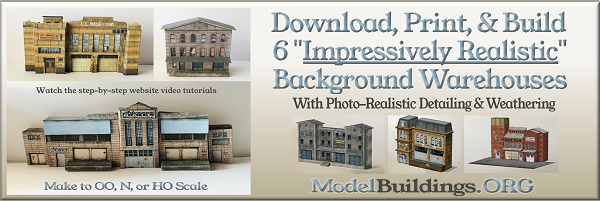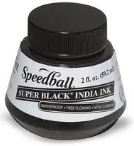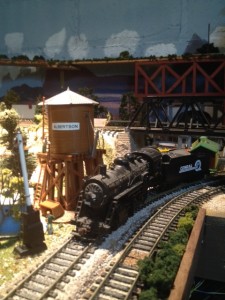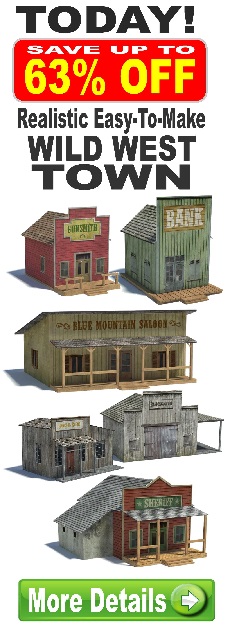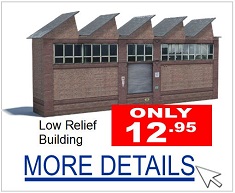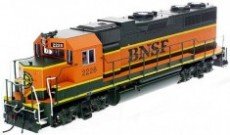Everything on model trains, model railroads, model railways, locomotives, model train layouts, scenery, wiring, DCC and more. Enjoy the world's best hobby... model railroading!
To Block Or Not?
Newcomer Bob is hoping for some good advice from experienced RR’s and asks:
“I am new to the hobby and am beginning to build an N-gauge layout on a 4×8 tabletop with no reverse loops. I will be using DCC. How do I know if I should divide the track into blocks or not? I plan to run no more than 2 trains at one time, at least for now. Will blocks allow me more freedom for expansion in the future? At this point I’m still pretty overwhelmed by it all! Thanks for any advice.”
Add your suggestions to help newcomer to the hobby Bob.
Mixing DC and DCC Locos
Darren sent in this tip:
Don’t overdo automatic reverse loops. I prefer to wire reversing loops the old-fashioned way. I do this because I like to run both conventional DC locos with my DCC locos and I don’t want my old locos to unexpectedly reverse direction.
Use the link in the right hand column to send in your tip or article for publication.
Click here for more DCC Tips and Techniques
4 Golden Rules For Backdrops
Ralph sent in his 4 golden rules for creating realistic backdrops:
1. Lower objects appear to be further away.
2. Higher objects seem closer
3. Distant objects have softer edges
4. Distant objects appear to be grayer
Follow these golden rules and your backdrop will look realistic.
Use the link in the right hand column to send in your tip or article for publication.
Changing DC Layout to DCC
Sharad asks readers for advice:
“I Specialise in OO/HO gauge, and have 15 steam locomotives collected over 20 years. Eight of these are from Bachmann, 5 from Hornby and 2 from an Indian manufacturer. Of the 8 Bachmann locos, 4 are DCC which I have purchased this year.
1. My question is: How can I run all the trains together- Analog (DC) with the DCC. Please advise me how to convert the DC to DCC. Should I maintain 2 track systems: DC and DCC?
2. The layout I am constructing is in a newly acquired garage 9x 16 Please advise me whether I should have along the wall layout or in the centre of the garage. Please advise me.”
Add your suggestions.
How To Add Realism To A Backdrop
When you think about it, a backdrop can have just about as much surface area as the model railroad itself. That’s why a backdrop is an integral part for any layout. Having a perpendicular orientation to your line of sight requires special thought.
In real life we view things in 3D, yet when you add anything extra to a backdrop (apart from blue sky), there is always the risk the backdrop will lose the 3D illusion. Painting clouds, mountains, and structures onto the background can look effective when viewed straight on. When viewed from a different angle however, the illusion of 3D can suddenly be lost.
Here are some tips for creating effective backdrops:
Keep the horizon low and make sure anything that is supposed to be vertical is vertical eg. telegraph poles, people, trees, buildings etc. Avoid abrupt horizon lines. Use trees, buildings, hills, or bridges to hide the meeting line where the vertical backdrop meets the horizontal layout. Avoid deep or bright colors for the sky. Light muted shades can work best. Soften and lighten the distant colors.
Although you won’t want everything to look artificially perfect, you also won’t want the eye to be drawn to something that looks out of place e.g. a dark blue sky. Vehicles need to be correctly positioned in the streets and not be cocked at strange angles.
Buildings painted on a background can sometimes look okay when there are other buildings or features in front of them. Otherwise it is best to design the buildings to stand out from the backdrop in low relief with the front and part of a couple of the sides showing. This can help achieve a credible 3D effect.
For more scenery tips http://www.modelrailwayscenery.org/model-railroad-scenery.html
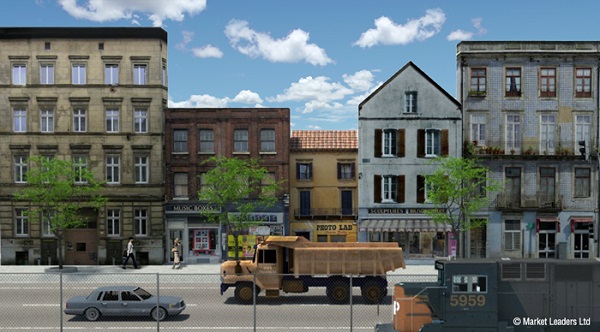
The buildings shown here are low relief buildings made from core flute. Foam core can be used instead. Both materials are very inexpensive to buy and are readily obtainable from Hardware DIY stores.
To get a close-up look at the detailing on the buildings in this town scene http://www.modelbuildings.org/low-relief-buildings.html
Add your suggestions.
Why Does The Solder Joint Just Look Ugly?
Ugly solder joints can be a result of inexperience or maybe the surfaces or tip is dirty. It is an indication the solder did not properly flow, and that perhaps the soldering iron might also not have been hot enough. A good solder joint is typically flat and shiny. To achieve a good solder flow, you will need to have the surfaces clean and shiny, and the iron heated to maximum temperature, before the solder touches the tip of the iron.
Read the comments.
If you would like to learn more about DCC operation http://www.dccmodeltrains.org
POLL RESULTS: Are Model Train Manufacturers Doing Enough To Promote Model Railroading?
The latest survey asked “Are Model Train Manufacturers Doing Enough To Promote Model Railroading?”
415 model railroaders responded as follows:
— No, I think they could do more (79%, 326 Votes)
— Yes, I think they are (21%, 89 Votes)
Add your comment
Building A Custom Layout
Nathan has a question for readers:
“I was wanting to hear ideas for a custom HO layout. I am kinda new to this. The size doesn’t matter unless it’s bigger than 150 sq ft. I only have cheap set locos but I have got 10 of them. Any help is appreciated. Thanks.”
Add your suggestions here.
1940’s 1950’s Layout
A reader wants your advice:
“I’m planning a N scale layout based during the late 40s to late 50s. I will be including a Switcher/Yard engine for my small branch line’s yard. My layout is a simple D.C. arrangement that will be up-graded to D.C.C. at a later time. Thanks for what advice I can get.”
Joe’s HO Scale Layout
Joe sent in these photos of his HO layout to share.
After reading a recent article on layouts for small areas, I decided to breakdown my 4×8 and construct a layout around the room. I painted the walls with forest and mountains and clouds. I was able to construct a two tier track pattern that are separate. The third set of tracks Is a trolley running from one side to the other.
Imagination was a big part of the scenery. This HO DCC layout was fun to build and even more fun when my grandchildren come and their eyes go wide as I shut the lights and turn on the street lamps, buildings, and neon signs. It seems to come to life. A small area doesn’t have mean a small layout.
Add a comment.
KATO Track Feeders
Bob sent in this question for readers:
“I’m re-doing my N Scale layout and I plan on using KATO Unitrack. My question is: How many feeder tracks do I need per 10 feet of track? This will be DCC controlled. I’ve been told that it’s not like using Atlas and others as the connectors on the Unitrack carry the electricity better. On my old layout I had feeders every 2 feet, sometimes closer. I was thinking a feeder every 5 feet. Too far? Thanks.”
Add your suggestion.
A Keen Hobbyist Has His Say
If model train manufacturers want to promote the hobby it should be done through advertising, something that model railroading doesn’t get enough of. This is the view of at least one keen model railroader (watch video). Do you agree?
Add your comment to this posting and/or take part in the poll.
POLL RESULTS: Do You Operate DC Or DCC?
There was a great response to last weeks poll which asked: Do You Operate DC Or DCC?
In all 841 model railroaders had their say with the majority (53%) of railroaders saying they operate DCC. Another 20% hoped to convert.
Although I’m not a professional pollster, I did notice one thing of significance.
Throughout the polling the percent results remained constant, indictating (to me) that the results were very accurate and hardly changed as more and more people voted. Here are the survey results:
>> DCC – I have always operated DCC (14%, 120 Votes)
>> DCC – I converted from DC to DCC (39%, 326 Votes)
>> DC – I hope to convert to DCC at some stage (20%, 169 Votes)
>> DC – I will be sticking with DC (19%, 162 Votes)
>> I don’t have a layout yet (8%, 64 Votes)
Click here for more DCC info
Making Your Layout Appear Bigger
Positioning buildings in front of the background scenery (or backdrop) can give the impression the layout is bigger than it actually is. When done well, the distant scenery can appear go on forever. Trees or a road disappearing behind a hill can give a similar effect.
This quick video shows an easy way to construct a building in low relief. The building can be made with 3 sides and a roof, or just attach the front directly onto the backdrop. The construction material is either core flute or foam core… both are available from a hardware store. A big sheet will probably cost you less than $10 and make lots of buildings. Also remember, because the building will probably be positioned in the background, you could make it smaller than the scale you are operating.
The plan is one of a series of six available from http://www.modelbuildings.org/Low-Relief-Buildings-B.html
